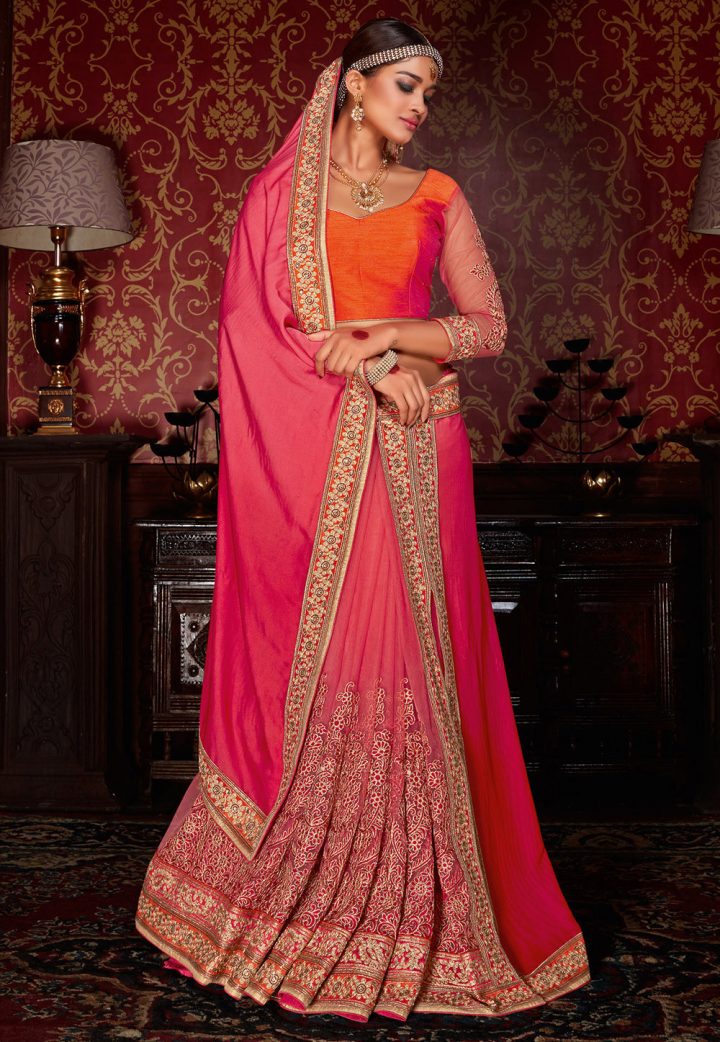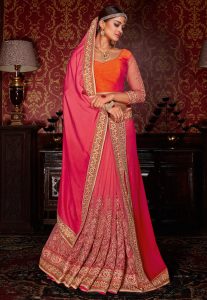
Pre-stitched Or Readymade Saree
A readymade saree, also known as a pre-stitched saree, is a saree that is no longer a 6 yard long continuous fabric that has to be draped. The elements of the saree’s draping i.e. the pleats and the pallu have already been pre- stitched in such a way that it need only be worn like a skirt and not draped like the conventional saree. Readymade sarees are a convenient clothing item that retains the grace and elegance of the conventional saree, only without the hassle of draping. Like the conventional saree, readymade sarees are also available in a multitude of fabrics, designs, patterns and styles.
The Background
Making an appearance in the early to mid-2000s, the readymade saree was conceptualized by renowned designers catering to foreign clients. These clients reportedly showed a keen interest in Indian ethnic fashion but were reluctant to purchase conventional sarees because the task of draping them was deemed cumbersome.
Slowly but surely, the need for readymade sarees was felt by women in India as well, especially professionals, since draping a saree was thought of as a time-consuming and burdensome task. The readymade saree which has a dress-time of 30 seconds, as opposed to 7-10 minutes with the conventional saree, is considered to be the ideal answer to a modern need for round-the-clock efficiency.
Therefore, designers stitch a matching petticoat (or the in-skirt), pleats and pallu into the garment. The blouse, however, needs to be worn separately.
Sources of Inspiration
While the innovation itself is inspired by trends of a modern, global, capital market promoting the need for every process to be faster and more efficient, the idea is similar to that of a skirt or lehenga. While the conventional lehenga was secured around the waist with a drawstring, modern versions have a zipper on the side. This is the technology that has been adopted by readymade sarees as well. There is a zipper on the side that fastens the skirt onto the waist.
The pallu is sourced from the conventional saree and is stitched in such a way that the fall and drape look exactly like that of a conventional saree.
The Making
The readymade saree is made using a regular sewing machine. A tailor needs the following measurements to create a readymade saree:
- The distance between the waist (where you tie your saree) to the floor. If one plans on wearing stilettoes or heels with it, this distance then should also be included in the measurements.
- The measurements of the waist (girth) in inches.
- The measurement around the hips in inches.
- Depending on the style and cut of the skirt, the tailor may also need measurements around the knees.
The tailor will sew the saree on to the petticoat with the pleats pre-arranged on the front. One can also opt for an inner lining instead of a petticoat if need be. Next, one end of the pallu is stitched in with the skirt and the zipper is aligned to the side of the waist.
Style and Variety
The saree is one of the most diverse Indian ethnic garments one can find in the country. Showcasing a number of different embroidery techniques, patterns, embellishments on innumerable fabrics, it is the mark of a saree to appeal to all kinds of style sensibilities. Readymade sarees are no different. Silk, jacquard, chiffon, georgette, net, satin blends, viscose blends, cotton, polyester blends and all their variants along with faux blends are perfectly capable of being cast as a readymade saree. Even special types such as ghicha silk sarees, handloom cotton, the Kerala Kasavu Saree and all others can easily be pre-stitched.
Since the premise of the readymade saree is to mold the 6-yard fabric by stitching, the strength of the fabric is the primary concern; which modern innovations have proven is no problem. Given that all fabrics can be converted into readymade sarees, there are no bars on the design and patterns of the sarees themselves.
Present Day Scenario and Global Influence
A large number of Indian women as well as ladies of other nationalities who admire the saree but have next to no knowledge on how to drape it are opting for readymade sarees. It has been noted that readymade sarees are very popular with women who have Indian roots but are settled in Western countries.
Although there is no constraint on the kind of saree that can be pre-stitched it is popular for fancy and festive sarees to be pre-stitched as opposed to daily wear ones. These outfits are an especially popular choice during the wedding season as it cuts down on the amount of time taken to get ready amidst all the last minute chaos of a Big Fat Indian Wedding.
Innovations
Although a readymade saree is an innovation in and of itself, there are other trends that are emerging within its purview. While pre-stitched sarees are readily available in the market, one can turn a conventional saree into a readymade one just as easily. If one already owns a desirable saree which is not being used due to the hassle and time usurpation of draping it, it can be taken to a practiced tailor or boutique and turned into a readymade saree.
Designers have gone so far as to create readymade sarees over a pair of pants that can be slipped on and zipped up. The look, fall and grace remain the same but with added convenience for those who are uncomfortable wearing skirts.
Wearing the Attire
There are merely three steps in donning a readymade saree:
Step 1: Step into the saree with the stitched-in petticoat.
Step 2: Fasten the zip at a comfortable height i.e. between the upper waist and lower waist.
Step 3: Take the remaining length of fabric around the body and drape it over the left shoulder.
Depending on the style of the saree as well as the occasion, one can accessorize accordingly.
Maintenance
Sarees are best maintained when dry-cleaned. However, if it does need to be washed then the machine must be set to washing delicate clothes with mild soaps and suds. Dry the saree in a cool, shaded area to avoid fading of colors.
The maintenance will also depend upon the fabric and work on the saree. Silk sarees should not be washed whereas cotton ones may. Similarly, sequin or stone work sarees have delicate threadwork in them and should not be washed whereas printed sarees can be washed easily.
Facts and Trivia
- A saree can vary in length between 5 to 9 yards.
- Renowned designers have been flaunting variants of the readymade saree on international runways for nearly half a decade.
- Pre-stitched sarees appeared prominently on the Bridal Fashion Week of 2014.
- Tucking in of pleats adds to the bulk around the waist. For healthier women, readymade sarees can reduce the bulk around the waist as the saree needs to be zipped up and not tucked in, thus slimming down the silhouette.
Reference Links
Categories: Ethnic Innovations, Outfits

